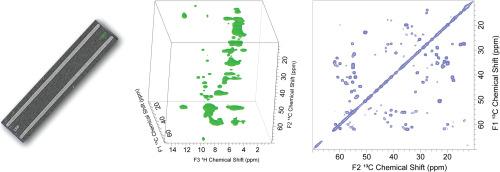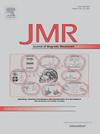高魔角旋转频率的金刚石转子
IF 1.9
3区 化学
Q3 BIOCHEMICAL RESEARCH METHODS
引用次数: 0
摘要
魔角旋转(MAS)核磁共振(NMR)光谱学的光谱分辨率受到固定分析物的转子旋转频率的限制。传统的钇稳定氧化锆(YSZ)转子具有机械限制,通常将0.7 mm转子的旋转频率限制在ωr/2π ~ 110 kHz。这些频率不足以达到与溶液核磁共振相当的分辨率,理论上需要ωr/2π >;300千赫。在先前利用旋转辅助钻孔的工作基础上,我们提出了金刚石转子制造的重大进展,使用高精度车床和无心激光加工夹具,实现了转子外径和内径的同心度和旋转稳定性的改善。新一代金刚石转子与布鲁克MAS 3纺丝系统的接口相当于或优于商用转子,使用0.7毫米的自动轮廓进行纺丝。此外,钻石转子可以清空和重新包装,我们描述了一套3d打印离心机工具,用于有效执行这一过程。我们评估了化学气相沉积(CVD)和高压高温(HPHT)钻石作为转子材料,发现高压高温(HPHT)更可取。扩展的自旋稳定性测试和Aβ1-40的多维核磁共振谱证明了这些转子的鲁棒性和可用性。这些进步为未来用氦气进行更高频率旋转铺平了道路,使生物和材料科学的MAS NMR实现了变革性改进。本文章由计算机程序翻译,如有差异,请以英文原文为准。

Diamond rotors for high magic angle spinning frequencies
Magic Angle Spinning (MAS) nuclear magnetic resonance (NMR) spectroscopy is limited in spectral resolution by the spinning frequency of rotors that hold the analyte. Traditional yttria-stabilized zirconia (YSZ) rotors have mechanical constraints that typically limit spinning frequencies of 0.7 mm rotors to ωr/2π ∼ 110 kHz. These frequencies are not sufficient to achieve resolution comparable to that of solution NMR, which theoretically requires ωr/2π > 300 kHz. Building upon prior work that utilized rotary-assisted drilling, we present significant advances in diamond rotor fabrication using a high precision lathe and a centerless laser machining fixture that achieves improved concentricity of the rotor outer and inner diameters and spinning stability. The new crop of diamond rotors, which interface with the Bruker MAS 3 spinning system equivalently or better than commercial rotors, were spun using automatic 0.7 mm profiles. Furthermore, diamond rotors can be emptied and repacked, and we describe a set of 3D-printed centrifuge tools for efficient execution of this process. We evaluate chemical vapor deposition (CVD) versus high-pressure high-temperature (HPHT) diamonds as rotor material and find HPHT preferable. Extended spin stability tests and multidimensional NMR spectra of Aβ1–40 demonstrate the robustness and usability of these rotors. These advances pave the way for higher frequency spinning with helium gas in the future, enabling transformative improvements in MAS NMR for biological and material sciences.
求助全文
通过发布文献求助,成功后即可免费获取论文全文。
去求助
来源期刊
CiteScore
3.80
自引率
13.60%
发文量
150
审稿时长
69 days
期刊介绍:
The Journal of Magnetic Resonance presents original technical and scientific papers in all aspects of magnetic resonance, including nuclear magnetic resonance spectroscopy (NMR) of solids and liquids, electron spin/paramagnetic resonance (EPR), in vivo magnetic resonance imaging (MRI) and spectroscopy (MRS), nuclear quadrupole resonance (NQR) and magnetic resonance phenomena at nearly zero fields or in combination with optics. The Journal''s main aims include deepening the physical principles underlying all these spectroscopies, publishing significant theoretical and experimental results leading to spectral and spatial progress in these areas, and opening new MR-based applications in chemistry, biology and medicine. The Journal also seeks descriptions of novel apparatuses, new experimental protocols, and new procedures of data analysis and interpretation - including computational and quantum-mechanical methods - capable of advancing MR spectroscopy and imaging.

 求助内容:
求助内容: 应助结果提醒方式:
应助结果提醒方式:


